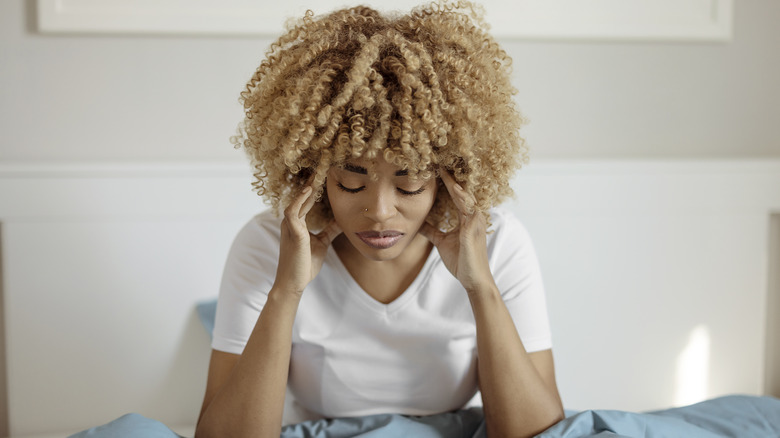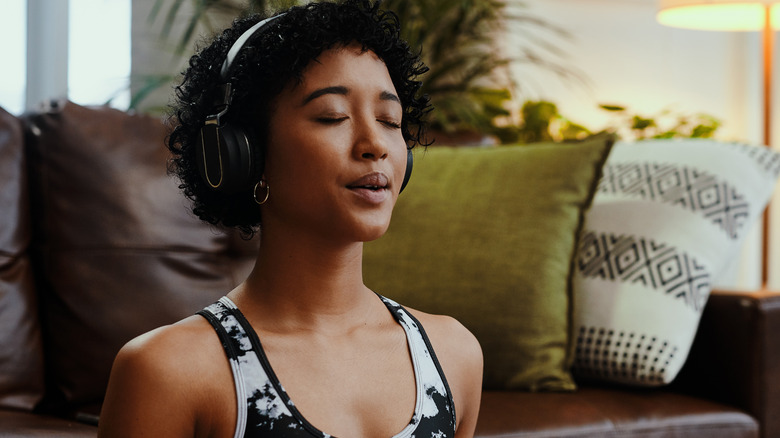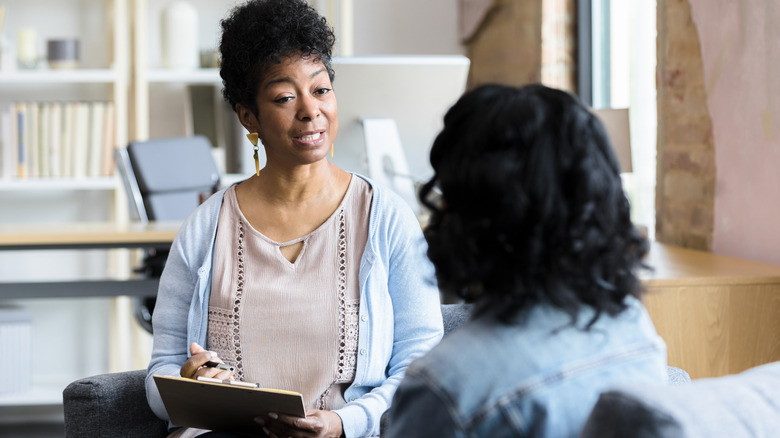Overcoming The Physical Toll Of Anxiety And Depression (Because It's Not All In Your Head)
For people who suffer from mental health disorders like anxiety and depression, the effects can reveal themselves in physical ways. Although we know anxiety can sometimes lead to panic attacks, which are absolutely physical when they happen, panic attacks are not the only physical ailments that anxiety can cause. Depression has its own brand of physical symptoms too. When the mind is at the helm, there's no telling exactly what physical form it might take, as it's different from person to person.
"The brain is intimately connected to the body and the body to the brain," psychiatrist and professor at Stanford University School of Medicine Dr. David Spiegel told The New York Times. "The body tends to react to mental stress as if it was a physical stress."
According to the World Health Organization, roughly 280 million people have depression and 301 million have an anxiety disorder worldwide. While not everyone gets the treatment they need, having the knowledge of what these physical signs might look like and how to navigate them can help in managing these often-debilitating mental illnesses.
Recognize the physical symptoms
Although depression and anxiety show themselves in different ways to different people, depending on the extent of the illness, it's important to recognize the physical symptoms if you want to overcome them. When you're dealing with anxiety and/or depression, it can lead to sleep problems, muscle aches, digestive-related issues, shakiness, headaches, and other symptoms. But what needs to be done is to realize that your inability to sleep, body pains, and all the other physical characteristics that come with these mental illnesses aren't just one-offs.
Sure, everyone gets the occasional headache, but if you experience chronic headaches combined with other symptoms that are associated with depression and anxiety, then you need to take a step back and realize that you might be dealing with something bigger than the occasional bout with these ailments. You can't move forward in coping with or, in some cases, learning to live with these two mental illnesses — that the Mayo Clinic notes often go hand-in-hand — if you don't recognize that your body is absolutely trying to tell you something when it behaves in certain ways.
Assess the situation
Even if you know that you suffer from depression or anxiety, that doesn't necessarily mean you've experienced the physical symptoms yet. That's why you want to acquaint yourself with them, so if they do rear their ugly head, you can get in front of them and have a plan for how you can subdue them.
"Doctors see it all the time — patients with real pain or other symptoms, but nothing is physically wrong with them," professor of psychiatry at Harvard Medical School Dr. Arthur Barsky told Harvard Health Publishing. "Anxiety and stress themselves produce these physical symptoms, and on top of that, your reaction to those symptoms can make them worse. The more you focus on them, the more alarmed you become, and the more intense your symptoms become... It can get really out of control and become so uncomfortable that you might not be able to do much more than sit and worry."
Knowing what to look for and how to interpret the feelings when the physical components start taking over are the best ways to mentally prepare and give yourself the opportunity to assess what might have induced the physical part of your mental illness.
Give yourself a pep talk
If you know that these physical symptoms, no matter how terrifying they are, are due to depression or anxiety, it's important to reassure yourself that the shortness of breath, chest pains, or similar scary symptoms aren't going to be fatal. Granted, when you're in the throes of an episode in which you feel like you're at the mercy of the illness, trying to talk yourself back down to ground zero isn't easy. That's why it's important that, as often as possible, you practice mindfulness.
A 2019 study published in Frontiers in Psychology, looked into the effect that mindfulness has on people who suffer from anxiety and depression. According to the research, those who were able to harness mindfulness experienced lower levels of anxiety and depression, both directly and indirectly. When the study examined the effect of mindful meditation on these two illnesses, the researchers found that the meditation didn't reduce feelings and symptoms directly, but did so indirectly. In other words, if you're mindful of your symptoms and can recognize them, ideally as they start to begin, you'll have a better chance at holding yourself together and talking your way through it.
Limit triggers
Like any mental illness, both anxiety and depression can be triggered. Although anxiety and depression can have many different triggers, because the two illnesses often overlap, some of those triggers are the same. According to Healthline, anxiety triggers may include certain medications, stress over finances, socializing, conflict or relationship problems, and failing to eat throughout the day. As far as depression is concerned, triggers may include stress, not getting enough sleep, being around negative people, not connecting enough with loved ones, not eating nutritious foods, and spending too much time on social media, per Healthline.
Once you realize what might trigger you to have a depressive episode or elevate your anxiety, then you can prepare. For example, if you're grieving, don't try to self-medicate with substances like alcohol or drugs as they're just going to exacerbate things. If you're stressed out, and feeling jittery and shaky, skip the coffee and have a juice instead. While you won't be able to always stop your depression and anxiety in its tracks, making an effort to limit triggers will put you in a better place, mentally, to handle any onslaught of physical symptoms.
Do the work
The most actionable thing you can do to overcome the physical toll of anxiety and depression is to do the work. That means, first and foremost, acknowledging you have a mental health condition. Although once something that people were embarrassed to admit to out of fear that it caused judgment from others, a 2019 survey by the American Psychological Association found that 87% of U.S. adults believe that there's nothing shameful about having a mental health disorder.
When you've acknowledged it and recognized the physical symptoms, then it's time to be proactive — and this means more than just avoiding triggers. It means learning to meditate, practice breathing techniques to help you feel centered, and creating a routine for yourself so you have order in your life. It also means realizing when you need professional help — for example, cognitive behavioral therapy (CBT), which has proven to be a great asset for those with depression and anxiety as well as other mental illnesses, via the Mayo Clinic. Even if you aren't sure what to talk about or how to start therapy, seeking help can greatly benefit you.
While there may not be a hard and fast cure for depression or anxiety, treatment and acknowledgment (meaning you're in not denial), can help you manage your mental and physical symptoms. When we learn how to handle these aspects of ourselves, it gives us a chance to not only overcome them, but live with them in a healthy, productive way.





